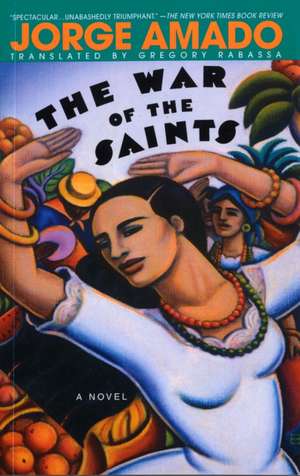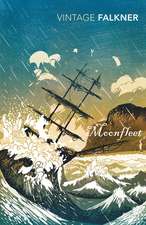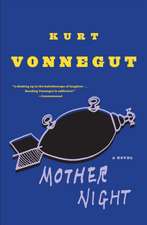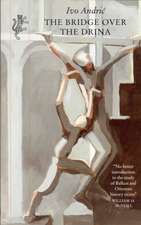The War of the Saints
Autor Jorge Amado Traducere de Gregory Rabassaen Limba Engleză Paperback – 31 ian 1995
Preț: 108.91 lei
Nou
Puncte Express: 163
Preț estimativ în valută:
20.84€ • 21.82$ • 17.29£
20.84€ • 21.82$ • 17.29£
Carte disponibilă
Livrare economică 20 martie-03 aprilie
Preluare comenzi: 021 569.72.76
Specificații
ISBN-13: 9780553374407
ISBN-10: 0553374400
Pagini: 368
Dimensiuni: 133 x 209 x 20 mm
Greutate: 0.28 kg
Editura: Dial Press
ISBN-10: 0553374400
Pagini: 368
Dimensiuni: 133 x 209 x 20 mm
Greutate: 0.28 kg
Editura: Dial Press
Extras
Chapter One
The Crossing
Casting Off
That day, though the hour was surprisingly late, the Sailor Without a Port was only just entering the far side of the Bay of All Saints, from upriver, under full sail–the sea, a blue mantle, the lover told his beloved. And strangely enough, in the wake of the wind, Maria Clara's voice was not to be heard trailing off in the throes of a love song.
If it happened that way it was simply because, in addition to the customary cargo of aromatic pineapples, cashews, and mangos, at Santo Amaro da Purificação the sloop had undertaken the responsibility–the mission, we should say–of transporting to the state capital a statue of Saint Barbara of the Thunder, famed for her eternal beauty and miraculous powers. Despite the evident displeasure of the vicar, the parish had agreed to loan the statue, to be displayed at a highly touted religious art exhibit that was being celebrated in prose and verse in the press and among intellectuals: "The cultural event of the year," as the newspapers proclaimed. In order to carry out this sacred commission, the sloop's captain, Master Manuel, had had to put off his habitual morning departure, delaying almost twelve hours, but he did it willingly: It would be worth the trouble, and besides, Dona Canô never requested favors, she gave orders.
The vicar felt less upset when he learned that a priest and a nun were also going along; he was young and modern, hair in disarray, wearing civilian clothes, while she was on in years, thin, pale, in a black habit. Divine providence, which never fails, had sent them to accompany the saint.
"Look after her during the crossing. Pay particular attention at the mouth of the river–the currents are tricky there, and the wind blows hard. God go with you."
Aided by the vicar, the sexton, and Dona Canô, amidst the prayers and applause of a fidgety gathering of church biddies, the priest and the nun proceeded with the embarkation ceremony. During the slippery descent, however, they preferred to entrust the litter that bore the figure on its pilgrimage into the seafaring hands of Master Manuel and his wife Maria Clara, who deposited it with reverential care in the stern of the sloop. There, standing erect, the majestic effigy of the Catholic saint looked like a ship's figurehead, a votive carving for the bow, a pagan and protective entity.
The Nun and the Priest
As the late afternoon breeze filled its proud sails, the sloop sped along with the saint. At the helm, Master Manuel smiled at the reverend father and the good sister: Don't be afraid, Saint Barbara's in no danger.
Sitting alongside the litter, Maria Clara saw to the stability of the saint, prevented the lurching of the sloop from upsetting its balance. "Don't you worry," she had added to reassure them, while she examined and praised the extravagance of the lining of the litter, made with all the refinements of brocade and ribbon, trimming and lace fashioned for the occasion by the devout ladies of the sisterhood of Our Lady of the Good Death in the neighboring town of Cachoeira, pious old women, first-rate artists. Oh, if it had been up to them, the saint would have traveled all covered with gold and silver, old gold, sterling silver, but the director of the museum had peremptorily turned them down. He'd even refused the sisterhood's reliquary–nasty man!
They had been trustworthy vows, those of the captain and his wife, yet the old nun, huddled in her worn and severe habit, trembled for the safety of the figure throughout the long voyage, because of the river currents or the rough seas of the gulf. But she didn't say a word, didn't let her concern show; only prayed, reciting over and over the beads of her rosary, until the breeze that fluttered about the carving came to comfort her bony hands. For her the trip was long and worrisome; she breathed easily only when the sloop headed in toward the market ramp. All had gone well, God be praised! she thought. The saint and her sack of thunder and lightning would soon be in the Museum of Sacred Art, where the director, a German monk with several advanced degrees, a scholar three times over, a renowned author, in his impeccable white cassock, awaited her impatiently. He'd developed a breathtakingly daring thesis concerning the origin and the artist of this famed piece of religious sculpture. Only then, delivered from her prison of fear, would Sister Maria Eunice close her eyes, let out a sigh of relief, and succumb at last to the soft enveloping breeze.
The priest, for his part, didn't look like a priest–how could anyone recognize him as a father when he was wearing blue jeans and a flowered shirt open to the wind, with no tonsure shaved into the center of his flowing hair? He was a good-looking fellow who drew women's stares. The habit doesn't make the monk, teaches a wise proverb that dates back quite a bit, to a time before such changes in costume and custom were common. In spite of the apparent disorder in his clothes and hair, his lack of cassock and tonsure, this was no hippie on his way to the peace and love colony in Arembepe, but an ordained priest, sincere in his vocation and his apostolate, devoted to his mission. In the distant parish that was his charge, the faithful were God's unfortunates, slaves of the rich, humbled by the age-old law of violence.
For him the trip had seemed longer, endless even, because he'd been living amid impunity and injustice and had every reason to believe he was being summoned to the capital for something besides praise or encouragement. He'd heard of provocations and threats, he'd read items in the papers denouncing and condemning the subversive activity of certain priests. His name, Father Abelardo Galvão, had appeared in the press, in twisted stories that turned facts upside down, invented things, slung mud, vilified him. That was all infamy and villainy, the priest pondered to himself. In truth, all he knew about Patrícia was the crystal tone of her voice, the enigma of her smile, the coquetry of her look. With these venomous insinuations, the bastards were trying to hide the corpses that lay rotting in the mangrove swamps among the guaiamu crabs. The priest was traveling with three dead men on his mind. He knew who had ordered them killed, everybody knew. It did no good to know, however; the ones who give orders to gunmen sail on, unsullied and inaccessible, beyond good and evil. The land has its owners, only a few, and they can be counted on the fingers of both hands–only a few, but they are implacable.
Some Modest Information Concerning Bahia
In spite of the fact that Maria Clara's soft voice, recalling oaths of love, joys, and sorrows, couldn't be heard, as she sat beside the figure of the saint she was actually humming little popular tunes, a special offering owed to saints and the enchanted. Her melodies didn't carry to the nun or the priest but summoned green swarms of water hyacinths that encircled the stout hull of the sloop. On their fleshy stems the newly opened blue flowers bowed, greeting Saint Barbara of the Thunder. The Paraguaçu River has the smell of tobacco and tastes like sugar; the vessel sailed between cane brakes and tobacco fields.
In the seas of the gulf, schools of fish greeted the sloop. A cortège of octopuses, rays, and skates accompanied its wake. The sun spread gold over the sky of the Bay of All Saints.
It is well known that the Bay of All Saints is the doorway to the world. Immeasurable, all other inlets in Brazil can fit into it, with space left over for the estuaries of Galicia and all the fleets in the universe. As for its beauty, there's no possible comparison, nor does the writer exist who is capable of describing it.
A flock of islands, each more delightful and dazzling than the one before, grazes on this sea of dreams, shepherded by the largest island, Itaparica, settled by Portuguese and Dutch soldiers, Indian tribes, and African nations. In the depths of the waters, in the realm of Aioká, lie the hulks of caravels armed for war, Portuguese noblemen, Batavian admirals, colonists and invaders expelled by dauntless Brazilian patriots. Itaparica is the mother of the new nation, the soil of freedom during the battles for independence commemorated every January.
Prudence ordains us not to speak of the glories of the Bay of All Saints–it's best to remain silent so as to avoid resentment and jealousy; its fame is already in the mouths of seafaring men, in the songs of troubadours, in the letters and reports of navigators. We won't give in here to voicing the glories of the bay, nor will we sing praises in its name. Modesty is the perquisite of true greatness.
In the bosom of the gulf, in the breezes of the peninsula, set on the hill, rises the City of Bahia, its full name, Cidade do Salvador da Bahia de Todosos Santos, exalted by Greeks and Trojans, celebrated in prose and verse, capital of all Africa, situated in the east of the world, on the sea lane to the Indies and China, on the meridian of the Caribbean, fat with gold and silver, perfumed with pepper and rosemary, copper-colored, flower of mulattery, port of mystery, beacon of enlightenment.
Much more could be said concerning this City of Bahia were it not for our modesty and prudence. Now, toward its docks, bearing their tales and humming their songs, heads the Sailor Without a Port, Master Manuel at the helm, his wife Maria Clara watching over the litter. As passengers it carries a priest and a nun and the image of Saint Barbara of the Thunder, who is leaving her simple altar in the main church of Santo Amaro da Purificação to take part in the religious art exhibit in the capital. Muted, Maria Clara's voice is in the diving of the fish, the flight of the sea swallows.
The Musician on the Drum
That afternoon, up on the market ramp, sitting on an empty kerosene barrel, a well-dressed black man wearing a white suit, bowtie, and two-tone shoes that shone with the glow of their polish was playing solos on the berimbau for a small audience of fruit vendors, idle urchins, and a pair of lovers. There was no group of capoeira foot-fighters to accompany him; the black man was playing for the simple pleasure of playing, the sound coming out of the remote past, from the depths of slave quarters, telling of the horrors of captivity.
Looking out in the direction of the sea fort, surprised, the musician recognized the outline of the Sailor Without a Port sailing along with the first shadows of dusk, instead of at the fringes of dawn, as it usually did, when it would carry the morning star atop its mast and Maria Clara's voice would awaken the sun:
The handsome sailor
Carried off by the mermaid . . .
How sweet to die in the sea,
In the dark green waves of the sea . . .
Dusk and dawn are equally good times to come and to go. Life is made up of the unexpected--isn't that what gives it its charm? The black man stopped playing, sharpened his ear, and heard the horn announcing the end of the crossing. Where had Maria Clara's voice been lost? Why couldn't the sailors' favorite melody be heard?
I'll give you a comb for your hair
The sky and sea I give you are fair . . .
With the majestic sound of the conch-horn, a triumphant cry echoed across the bay. What good news was the captain announcing to the city and its people? An intoxicating aroma of fruit enveloped the dock, the perfume of ripe jackfruit.
In the softness of late afternoon, in the opulence of the sunset, the sea and its fish delivered the sloop with the precious litter and the beauteous statue to its port of call, the vessel touching the cement of the market ramp. Maria Clara stood up, went to furl the sails while Master Manuel dropped the rope with the stone that served as an anchor. The Sailor Without a Port came to halt as the sun was exploding in the sky, in the evening sky of Bahia, in all the nuances of red, from rose to scarlet.
The Landing
Father Abelardo helped the nun to her feet. The two took deep breaths of relief, each disembarking in his and her particular haste. They had watched over the saint during the crossing and were no longer needed since, close to the ramp, the museum van could be seen parked and waiting to pick it up.
To receive the precious image the director had chosen Edimilson Vaz, a young and talented ethnologist and his trusted assistant. The director himself had been unable to go; at that precise moment he was hosting a well-attended press conference for both the print and broadcast media, to give them the details of the great exhibit, whose grand opening was scheduled for two days hence, on Friday evening. Attending the press conference were journalists from Bahia, correspondents from important newspapers from the south of the country, and crowning all, a representative from a chain of Portuguese newspapers, a certain Fernando Assis Pacheco. Even as the sloop was anchoring at the market ramp, the director had already begun to discourse on the antique carving of Saint Barbara of the Thunder. Why thunder, why did she have a knapsack full of lightning bolts where a castle and a palm tree should have been? he asked rhetorically. She was a capital work of the imagination that in just a few minutes would be lighting up this room, dazzling all you journalists! Speaking of thunder and lightning, dates and places, saint-makers and sculptors, there is some disagreement among musicologists, historians, and art critics, some pro, some con, yet all are extremely competent and the director even more so, his impeccable white cassock, his seraphic look making him seem roguish, even devilish, at times.
Before Master Manuel and Maria Clara had finished mooring the sloop and managed to lift out the saint, the saint herself got down from her litter, took a step forward, smoothed the folds of her cape, and walked off.
With a sway of her hips, Saint Barbara of the Thunder slipped between Master Manuel and Maria Clara and gave them a smile of complicity and affection. The êbômin then held her hands open before her breasts in a ritual gesture and said: "Eparrei, Oyá!" When she passed by the priest and the nun, she waved politely to the nun and winked at the priest.
Off went Saint Barbara of the Thunder, along the market ramp, heading toward the Lacerda Elevator. She was in a hurry because night was coming on and the time for the padê had already passed. The well-dressed black man bowed at the sight of her, touched the ground with his fingers, then lifted them to his forehead and repeated: "Eparrei!" The black man was Camafeu de Oxóssi, an obá of Xangô, a vendor in the market, a soloist on the berimbau, former president of the Children of Gandhi Afoxé, and not even he himself knew whether he had just happened to be present, or whether he had been allowed to witness this event through the work and grace of the enchanted ones. Before the lights came on in their lampposts, Saint Barbara Yansan had disappeared into the midst of her people.
The Crossing
Casting Off
That day, though the hour was surprisingly late, the Sailor Without a Port was only just entering the far side of the Bay of All Saints, from upriver, under full sail–the sea, a blue mantle, the lover told his beloved. And strangely enough, in the wake of the wind, Maria Clara's voice was not to be heard trailing off in the throes of a love song.
If it happened that way it was simply because, in addition to the customary cargo of aromatic pineapples, cashews, and mangos, at Santo Amaro da Purificação the sloop had undertaken the responsibility–the mission, we should say–of transporting to the state capital a statue of Saint Barbara of the Thunder, famed for her eternal beauty and miraculous powers. Despite the evident displeasure of the vicar, the parish had agreed to loan the statue, to be displayed at a highly touted religious art exhibit that was being celebrated in prose and verse in the press and among intellectuals: "The cultural event of the year," as the newspapers proclaimed. In order to carry out this sacred commission, the sloop's captain, Master Manuel, had had to put off his habitual morning departure, delaying almost twelve hours, but he did it willingly: It would be worth the trouble, and besides, Dona Canô never requested favors, she gave orders.
The vicar felt less upset when he learned that a priest and a nun were also going along; he was young and modern, hair in disarray, wearing civilian clothes, while she was on in years, thin, pale, in a black habit. Divine providence, which never fails, had sent them to accompany the saint.
"Look after her during the crossing. Pay particular attention at the mouth of the river–the currents are tricky there, and the wind blows hard. God go with you."
Aided by the vicar, the sexton, and Dona Canô, amidst the prayers and applause of a fidgety gathering of church biddies, the priest and the nun proceeded with the embarkation ceremony. During the slippery descent, however, they preferred to entrust the litter that bore the figure on its pilgrimage into the seafaring hands of Master Manuel and his wife Maria Clara, who deposited it with reverential care in the stern of the sloop. There, standing erect, the majestic effigy of the Catholic saint looked like a ship's figurehead, a votive carving for the bow, a pagan and protective entity.
The Nun and the Priest
As the late afternoon breeze filled its proud sails, the sloop sped along with the saint. At the helm, Master Manuel smiled at the reverend father and the good sister: Don't be afraid, Saint Barbara's in no danger.
Sitting alongside the litter, Maria Clara saw to the stability of the saint, prevented the lurching of the sloop from upsetting its balance. "Don't you worry," she had added to reassure them, while she examined and praised the extravagance of the lining of the litter, made with all the refinements of brocade and ribbon, trimming and lace fashioned for the occasion by the devout ladies of the sisterhood of Our Lady of the Good Death in the neighboring town of Cachoeira, pious old women, first-rate artists. Oh, if it had been up to them, the saint would have traveled all covered with gold and silver, old gold, sterling silver, but the director of the museum had peremptorily turned them down. He'd even refused the sisterhood's reliquary–nasty man!
They had been trustworthy vows, those of the captain and his wife, yet the old nun, huddled in her worn and severe habit, trembled for the safety of the figure throughout the long voyage, because of the river currents or the rough seas of the gulf. But she didn't say a word, didn't let her concern show; only prayed, reciting over and over the beads of her rosary, until the breeze that fluttered about the carving came to comfort her bony hands. For her the trip was long and worrisome; she breathed easily only when the sloop headed in toward the market ramp. All had gone well, God be praised! she thought. The saint and her sack of thunder and lightning would soon be in the Museum of Sacred Art, where the director, a German monk with several advanced degrees, a scholar three times over, a renowned author, in his impeccable white cassock, awaited her impatiently. He'd developed a breathtakingly daring thesis concerning the origin and the artist of this famed piece of religious sculpture. Only then, delivered from her prison of fear, would Sister Maria Eunice close her eyes, let out a sigh of relief, and succumb at last to the soft enveloping breeze.
The priest, for his part, didn't look like a priest–how could anyone recognize him as a father when he was wearing blue jeans and a flowered shirt open to the wind, with no tonsure shaved into the center of his flowing hair? He was a good-looking fellow who drew women's stares. The habit doesn't make the monk, teaches a wise proverb that dates back quite a bit, to a time before such changes in costume and custom were common. In spite of the apparent disorder in his clothes and hair, his lack of cassock and tonsure, this was no hippie on his way to the peace and love colony in Arembepe, but an ordained priest, sincere in his vocation and his apostolate, devoted to his mission. In the distant parish that was his charge, the faithful were God's unfortunates, slaves of the rich, humbled by the age-old law of violence.
For him the trip had seemed longer, endless even, because he'd been living amid impunity and injustice and had every reason to believe he was being summoned to the capital for something besides praise or encouragement. He'd heard of provocations and threats, he'd read items in the papers denouncing and condemning the subversive activity of certain priests. His name, Father Abelardo Galvão, had appeared in the press, in twisted stories that turned facts upside down, invented things, slung mud, vilified him. That was all infamy and villainy, the priest pondered to himself. In truth, all he knew about Patrícia was the crystal tone of her voice, the enigma of her smile, the coquetry of her look. With these venomous insinuations, the bastards were trying to hide the corpses that lay rotting in the mangrove swamps among the guaiamu crabs. The priest was traveling with three dead men on his mind. He knew who had ordered them killed, everybody knew. It did no good to know, however; the ones who give orders to gunmen sail on, unsullied and inaccessible, beyond good and evil. The land has its owners, only a few, and they can be counted on the fingers of both hands–only a few, but they are implacable.
Some Modest Information Concerning Bahia
In spite of the fact that Maria Clara's soft voice, recalling oaths of love, joys, and sorrows, couldn't be heard, as she sat beside the figure of the saint she was actually humming little popular tunes, a special offering owed to saints and the enchanted. Her melodies didn't carry to the nun or the priest but summoned green swarms of water hyacinths that encircled the stout hull of the sloop. On their fleshy stems the newly opened blue flowers bowed, greeting Saint Barbara of the Thunder. The Paraguaçu River has the smell of tobacco and tastes like sugar; the vessel sailed between cane brakes and tobacco fields.
In the seas of the gulf, schools of fish greeted the sloop. A cortège of octopuses, rays, and skates accompanied its wake. The sun spread gold over the sky of the Bay of All Saints.
It is well known that the Bay of All Saints is the doorway to the world. Immeasurable, all other inlets in Brazil can fit into it, with space left over for the estuaries of Galicia and all the fleets in the universe. As for its beauty, there's no possible comparison, nor does the writer exist who is capable of describing it.
A flock of islands, each more delightful and dazzling than the one before, grazes on this sea of dreams, shepherded by the largest island, Itaparica, settled by Portuguese and Dutch soldiers, Indian tribes, and African nations. In the depths of the waters, in the realm of Aioká, lie the hulks of caravels armed for war, Portuguese noblemen, Batavian admirals, colonists and invaders expelled by dauntless Brazilian patriots. Itaparica is the mother of the new nation, the soil of freedom during the battles for independence commemorated every January.
Prudence ordains us not to speak of the glories of the Bay of All Saints–it's best to remain silent so as to avoid resentment and jealousy; its fame is already in the mouths of seafaring men, in the songs of troubadours, in the letters and reports of navigators. We won't give in here to voicing the glories of the bay, nor will we sing praises in its name. Modesty is the perquisite of true greatness.
In the bosom of the gulf, in the breezes of the peninsula, set on the hill, rises the City of Bahia, its full name, Cidade do Salvador da Bahia de Todosos Santos, exalted by Greeks and Trojans, celebrated in prose and verse, capital of all Africa, situated in the east of the world, on the sea lane to the Indies and China, on the meridian of the Caribbean, fat with gold and silver, perfumed with pepper and rosemary, copper-colored, flower of mulattery, port of mystery, beacon of enlightenment.
Much more could be said concerning this City of Bahia were it not for our modesty and prudence. Now, toward its docks, bearing their tales and humming their songs, heads the Sailor Without a Port, Master Manuel at the helm, his wife Maria Clara watching over the litter. As passengers it carries a priest and a nun and the image of Saint Barbara of the Thunder, who is leaving her simple altar in the main church of Santo Amaro da Purificação to take part in the religious art exhibit in the capital. Muted, Maria Clara's voice is in the diving of the fish, the flight of the sea swallows.
The Musician on the Drum
That afternoon, up on the market ramp, sitting on an empty kerosene barrel, a well-dressed black man wearing a white suit, bowtie, and two-tone shoes that shone with the glow of their polish was playing solos on the berimbau for a small audience of fruit vendors, idle urchins, and a pair of lovers. There was no group of capoeira foot-fighters to accompany him; the black man was playing for the simple pleasure of playing, the sound coming out of the remote past, from the depths of slave quarters, telling of the horrors of captivity.
Looking out in the direction of the sea fort, surprised, the musician recognized the outline of the Sailor Without a Port sailing along with the first shadows of dusk, instead of at the fringes of dawn, as it usually did, when it would carry the morning star atop its mast and Maria Clara's voice would awaken the sun:
The handsome sailor
Carried off by the mermaid . . .
How sweet to die in the sea,
In the dark green waves of the sea . . .
Dusk and dawn are equally good times to come and to go. Life is made up of the unexpected--isn't that what gives it its charm? The black man stopped playing, sharpened his ear, and heard the horn announcing the end of the crossing. Where had Maria Clara's voice been lost? Why couldn't the sailors' favorite melody be heard?
I'll give you a comb for your hair
The sky and sea I give you are fair . . .
With the majestic sound of the conch-horn, a triumphant cry echoed across the bay. What good news was the captain announcing to the city and its people? An intoxicating aroma of fruit enveloped the dock, the perfume of ripe jackfruit.
In the softness of late afternoon, in the opulence of the sunset, the sea and its fish delivered the sloop with the precious litter and the beauteous statue to its port of call, the vessel touching the cement of the market ramp. Maria Clara stood up, went to furl the sails while Master Manuel dropped the rope with the stone that served as an anchor. The Sailor Without a Port came to halt as the sun was exploding in the sky, in the evening sky of Bahia, in all the nuances of red, from rose to scarlet.
The Landing
Father Abelardo helped the nun to her feet. The two took deep breaths of relief, each disembarking in his and her particular haste. They had watched over the saint during the crossing and were no longer needed since, close to the ramp, the museum van could be seen parked and waiting to pick it up.
To receive the precious image the director had chosen Edimilson Vaz, a young and talented ethnologist and his trusted assistant. The director himself had been unable to go; at that precise moment he was hosting a well-attended press conference for both the print and broadcast media, to give them the details of the great exhibit, whose grand opening was scheduled for two days hence, on Friday evening. Attending the press conference were journalists from Bahia, correspondents from important newspapers from the south of the country, and crowning all, a representative from a chain of Portuguese newspapers, a certain Fernando Assis Pacheco. Even as the sloop was anchoring at the market ramp, the director had already begun to discourse on the antique carving of Saint Barbara of the Thunder. Why thunder, why did she have a knapsack full of lightning bolts where a castle and a palm tree should have been? he asked rhetorically. She was a capital work of the imagination that in just a few minutes would be lighting up this room, dazzling all you journalists! Speaking of thunder and lightning, dates and places, saint-makers and sculptors, there is some disagreement among musicologists, historians, and art critics, some pro, some con, yet all are extremely competent and the director even more so, his impeccable white cassock, his seraphic look making him seem roguish, even devilish, at times.
Before Master Manuel and Maria Clara had finished mooring the sloop and managed to lift out the saint, the saint herself got down from her litter, took a step forward, smoothed the folds of her cape, and walked off.
With a sway of her hips, Saint Barbara of the Thunder slipped between Master Manuel and Maria Clara and gave them a smile of complicity and affection. The êbômin then held her hands open before her breasts in a ritual gesture and said: "Eparrei, Oyá!" When she passed by the priest and the nun, she waved politely to the nun and winked at the priest.
Off went Saint Barbara of the Thunder, along the market ramp, heading toward the Lacerda Elevator. She was in a hurry because night was coming on and the time for the padê had already passed. The well-dressed black man bowed at the sight of her, touched the ground with his fingers, then lifted them to his forehead and repeated: "Eparrei!" The black man was Camafeu de Oxóssi, an obá of Xangô, a vendor in the market, a soloist on the berimbau, former president of the Children of Gandhi Afoxé, and not even he himself knew whether he had just happened to be present, or whether he had been allowed to witness this event through the work and grace of the enchanted ones. Before the lights came on in their lampposts, Saint Barbara Yansan had disappeared into the midst of her people.
Recenzii
"Dazzling...a tour de force and irrefutable proof of the writer's artistic maturity...a carnival of rhythm and color." --Boston Sunday Globe
Descriere
The holy icon of Saint Barbara of the Thunder is bound for the city of Bahia for an exhibition of holy art. As the boat that bears the image is docking, a miracle occurs and Saint Barbara comes to life, disappearing into the milling crowd on the quay. It is up to her to save a young woman from missing out on the love of a lifetime.
Notă biografică
Jorge Amado—novelist, journalist, lawyer—was born in 1912, the son of a cacao planter, in Ilheus, south of Salvador, the provincial capital ofGabriela, clavo y canela. His first novel,Cacao, was published when he was 19. It was an impassioned plea for social justice for the workers on Bahian cacao plantations; and his novels of the ’30s and ’40s would continue to dramatize class struggle. Not until the 1950s did he write his great literary comic novels—Gabriela, clavo y canelaandDoña Flor y sus dos maridos—which take aim at the full spectrum of society even as they pay ebullient tribute to the region of his birth. One of the most renowned writers of the Latin American boom of the ’60s, Amado has been translated into more than 35 languages. A highly successful film version ofDoña Florwas produced in Brazil in 1976. He died in 2001.














